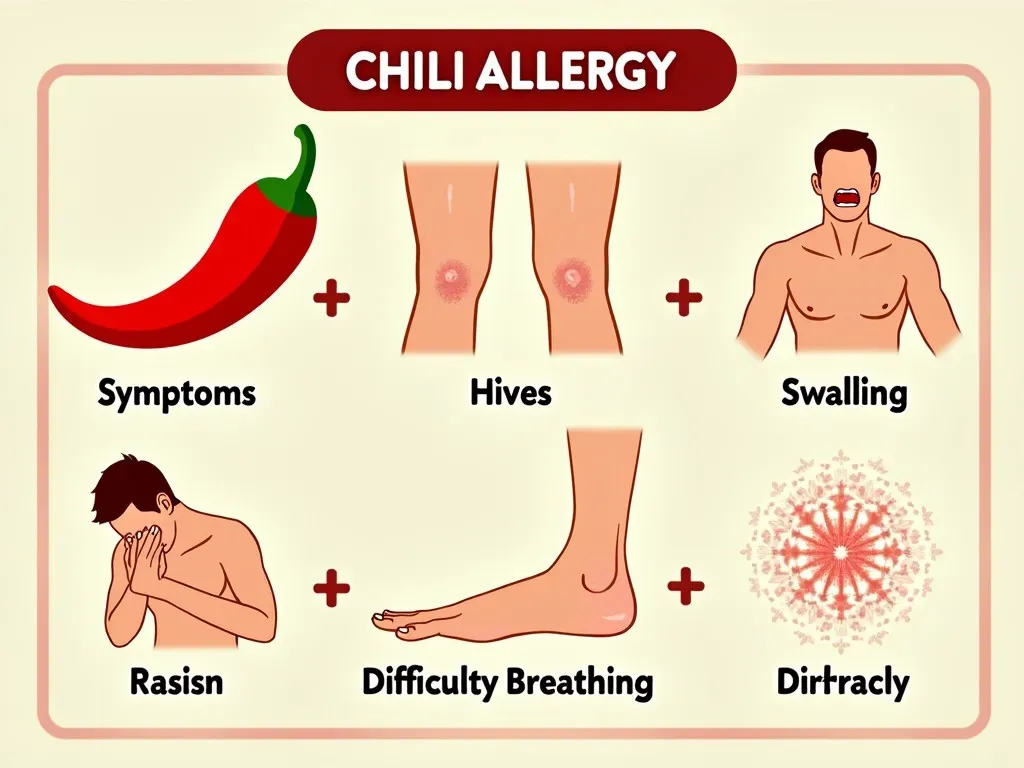Chili allergy can manifest in various ways, significantly affecting the lives of those who are susceptible. While chili peppers are a popular spice across many cultures, they remain one of the lesser-known allergens. In this article, we delve into the symptoms, causes, and treatments associated with chili allergies, along with essential facts for those affected.
Understanding Chili Allergy
A chili allergy occurs when the immune system reacts abnormally to proteins found in chili peppers. This may include a reaction not just to the chili itself but also to related spices due to cross-reactivity. Symptoms can range from mild to severe, affecting the skin, digestive system, and even respiratory function.
Facts About Chili Allergies:
| Fact | Details |
|---|---|
| Prevalence | Nearly 1-2% of the population may experience food allergies, including chili. (Source: Mayo Clinic) |
| Symptoms | Common symptoms include hives, itching, swelling, and gastrointestinal distress. |
| Cross-Reactivity | Chili allergies can be linked to allergies to Other nightshades, such as tomatoes and eggplants. |
| Diagnosis | Blood tests (IgE tests) and skin prick tests can help identify chili allergies. |

Symptoms of Chili Allergy
The symptoms of a chili allergy can present themselves in various forms. Here’s a comprehensive list of potential symptoms associated with this allergy:
Common Symptoms Include:
- Skin Reactions: Hives, itching, or eczema can occur when chili comes in contact with the skin.
- Respiratory Issues: Nasal congestion, sneezing, and difficulty breathing may arise.
- Digestive Disturbances: Nausea, vomiting, abdominal pain, and diarrhea are common gastrointestinal responses.
- Anaphylaxis: In extreme cases, exposure to chili can lead to a life-threatening reaction requiring immediate medical attention.
Symptoms of Capsaicin Allergy
Research suggests that the active component in chili peppers, capsaicin, may trigger additional reactions, such as:
- Burning sensations in the mouth and throat upon consumption.
- Contact dermatitis when chili products come into contact with skin.
Diagnosis and Testing
Diagnosing a chili allergy can be complex given the potential for cross-reactivity with other spices and food items. Here are common methods used for diagnosis:
- Skin Prick Test: Small amounts of the allergen are introduced into the skin to check for reactions.
- Blood Tests: Tests to measure IgE antibodies specific to chili peppers.
- Food Challenge: This safe method involves consuming small amounts of the suspected allergen under medical supervision to confirm allergies.
Managing Chili Allergy
For those diagnosed with a chili allergy, avoidance is the primary strategy. Here are some impactful guidelines:
- Read Labels: Always check product labels for any mention of chili or related spices.
- Inform Others: Make friends and restaurant staff aware of your allergy to avoid accidental exposure.
- Have Medication Ready: Carry antihistamines or an epinephrine auto-injector if prescribed by your doctor.
Foods to Avoid with Chili Allergy:
- Different forms of chili peppers (fresh, dried, powdered).
- Spicy sauces and marinades (salsa, chili sauce).
- Spice blends that may contain chili (some curry powders, Cajun spices).
Spice Allergy vs. Intolerance
It’s essential to distinguish between a spice allergy and spice intolerance. While an allergy often triggers an immune response and can be life-threatening, an intolerance usually leads to digestive discomfort—an example being capsaicin intolerance, which can cause severe abdominal pain without an immune system involvement.
FAQs
Q: Can you be allergic to spicy food?
A: Yes, some individuals are allergic to the compounds in spicy foods, such as capsaicin found in chili peppers.
Q: What are the symptoms of a cayenne pepper allergy?
A: Symptoms can include itching, hives, nasal congestion, and gastrointestinal distress similar to other chili allergies.
Q: Can you have a spice allergy test?
A: Yes, allergy tests including skin prick tests and blood tests can help determine specific spice allergies.
Q: What should I do if I suspect a chili allergy?
A: Consult an allergist for precise testing and guidance, and avoid suspected allergenic foods until diagnosed.
Conclusion
Understanding a chili allergy is crucial for those who suffer from it, as symptoms can vary widely and potentially lead to severe reactions. With careful management and awareness, individuals can enjoy a fulfilling life while avoiding this hazard.
To dive deeper into the topic, visit Verywell Health’s page on spice allergies.

Taking heed of these insights can empower those affected by chili allergies to navigate their culinary options safely, ensuring a delectable dining experience without compromising their health.
